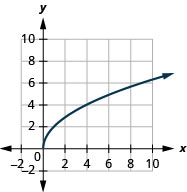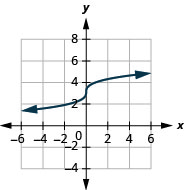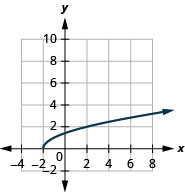Chapter 8 Review Exercises
- Page ID
- 19664
Chapter Review Exercises
Simplify Expressions with Roots
In the following exercises, simplify.
-
- \(\sqrt{225}\)
- \(-\sqrt{16}\)
-
- \(-\sqrt{169}\)
- \(\sqrt{-8}\)
-
- \(\sqrt[3]{8}\)
- \(\sqrt[4]{81}\)
- \(\sqrt[5]{243}\)
-
- \(\sqrt[3]{-512}\)
- \(\sqrt[4]{-81}\)
- \(\sqrt[5]{-1}\)
- Answer
-
1.
- \(15\)
- \(-4\)
3.
- \(2\)
- \(3\)
- \(3\)
In the following exercises, estimate each root between two consecutive whole numbers.
-
- \(\sqrt{68}\)
- \(\sqrt[3]{84}\)
- Answer
-
1.
- \(8<\sqrt{68}<9\)
- \(4<\sqrt[3]{84}<5\)
In the following exercises, approximate each root and round to two decimal places.
-
- \(\sqrt{37}\)
- \(\sqrt[3]{84}\)
- \(\sqrt[4]{125}\)
- Answer
-
1. Solve for yourself
In the following exercises, simplify using absolute values as necessary.
-
- \(\sqrt[3]{a^{3}}\)
- \(\sqrt[7]{b^{7}}\)
-
- \(\sqrt{a^{14}}\)
- \(\sqrt{w^{24}}\)
-
- \(\sqrt[4]{m^{8}}\)
- \(\sqrt[5]{n^{20}}\)
-
- \(\sqrt{121 m^{20}}\)
- \(-\sqrt{64 a^{2}}\)
-
- \(\sqrt[3]{216 a^{6}}\)
- \(\sqrt[5]{32 b^{20}}\)
-
- \(\sqrt{144 x^{2} y^{2}}\)
- \(\sqrt{169 w^{8} y^{10}}\)
- \(\sqrt[3]{8 a^{51} b^{6}}\)
- Answer
-
1.
- \(a\)
- \(|b|\)
3.
- \(m^{2}\)
- \(n^{4}\)
5.
- \(6a^{2}\)
- \(2b^{4}\)
Simplify Radical Expressions
In the following exercises, use the Product Property to simplify radical expressions.
- \(\sqrt{125}\)
- \(\sqrt{675}\)
-
- \(\sqrt[3]{625}\)
- \(\sqrt[6]{128}\)
- Answer
-
1. \(5\sqrt{5}\)
3.
- \(5 \sqrt[3]{5}\)
- \(2 \sqrt[6]{2}\)
In the following exercises, simplify using absolute value signs as needed.
-
- \(\sqrt{a^{23}}\)
- \(\sqrt[3]{b^{8}}\)
- \(\sqrt[8]{c^{13}}\)
-
- \(\sqrt{80 s^{15}}\)
- \(\sqrt[5]{96 a^{7}}\)
- \(\sqrt[6]{128 b^{7}}\)
-
- \(\sqrt{96 r^{3} s^{3}}\)
- \(\sqrt[3]{80 x^{7} y^{6}}\)
- \(\sqrt[4]{80 x^{8} y^{9}}\)
-
- \(\sqrt[5]{-32}\)
- \(\sqrt[8]{-1}\)
-
- \(8+\sqrt{96}\)
- \(\frac{2+\sqrt{40}}{2}\)
- Answer
-
2.
- \(4\left|s^{7}\right| \sqrt{5 s}\)
- \(2 a \sqrt[5]{3 a^{2}}\)
- \(2|b| \sqrt[6]{2 b}\)
4.
- \(-2\)
- not real
In the following exercises, use the Quotient Property to simplify square roots.
-
- \(\sqrt{\frac{72}{98}}\)
- \(\sqrt[3]{\frac{24}{81}}\)
- \(\sqrt[4]{\frac{6}{96}}\)
-
- \(\sqrt{\frac{y^{4}}{y^{8}}}\)
- \(\sqrt[5]{\frac{u^{21}}{u^{11}}}\)
- \(\sqrt[6]{\frac{v^{30}}{v^{12}}}\)
- \(\sqrt{\frac{300 m^{5}}{64}}\)
-
- \(\sqrt{\frac{28 p^{7}}{q^{2}}}\)
- \(\sqrt[3]{\frac{81 s^{8}}{t^{3}}}\)
- \(\sqrt[4]{\frac{64 p^{15}}{q^{12}}}\)
-
- \(\sqrt{\frac{27 p^{2} q}{108 p^{4} q^{3}}}\)
- \(\sqrt[3]{\frac{16 c^{5} d^{7}}{250 c^{2} d^{2}}}\)
- \(\sqrt[6]{\frac{2 m^{9} n^{7}}{128 m^{3} n}}\)
-
- \(\frac{\sqrt{80 q^{5}}}{\sqrt{5 q}}\)
- \(\frac{\sqrt[3]{-625}}{\sqrt[3]{5}}\)
- \(\frac{\sqrt[4]{80 m^{7}}}{\sqrt[4]{5 m}}\)
- Answer
-
1.
- \(\frac{6}{7}\)
- \(\frac{2}{3}\)
- \(\frac{1}{2}\)
3. \(\frac{10 m^{2} \sqrt{3 m}}{8}\)
5.
- \(\frac{1}{2|p q|}\)
- \(\frac{2 c d \sqrt[5]{2 d^{2}}}{5}\)
- \(\frac{|m n| \sqrt[6]{2}}{2}\)
Simplify Rational Exponents
In the following exercises, write as a radical expression.
-
- \(r^{\frac{1}{2}}\)
- \(s^{\frac{1}{3}}\)
- \(t^{\frac{1}{4}}\)
- Answer
-
1.
- \(\sqrt{r}\)
- \(\sqrt[3]{s}\)
- \(\sqrt[4]{t}\)
In the following exercises, write with a rational exponent.
-
- \(\sqrt{21p}\)
- \(\sqrt[4]{8q}\)
- \(4\sqrt[6]{36r}\)
- Answer
-
1. Solve for yourself
In the following exercises, simplify.
-
- \(625^{\frac{1}{4}}\)
- \(243^{\frac{1}{5}}\)
- \(32^{\frac{1}{5}}\)
-
- \((-1,000)^{\frac{1}{3}}\)
- \(-1,000^{\frac{1}{3}}\)
- \((1,000)^{-\frac{1}{3}}\)
-
- \((-32)^{\frac{1}{5}}\)
- \((243)^{-\frac{1}{5}}\)
- \(-125^{\frac{1}{3}}\)
- Answer
-
1.
- \(5\)
- \(3\)
- \(2\)
3.
- \(-2\)
- \(\frac{1}{3}\)
- \(-5\)
In the following exercises, write with a rational exponent.
-
- \(\sqrt[4]{r^{7}}\)
- \((\sqrt[5]{2 p q})^{3}\)
- \(\sqrt[4]{\left(\frac{12 m}{7 n}\right)^{3}}\)
- Answer
-
1. Solve for yourself
In the following exercises, simplify.
-
- \(25^{\frac{3}{2}}\)
- \(9^{-\frac{3}{2}}\)
- \((-64)^{\frac{2}{3}}\)
-
- \(-64^{\frac{3}{2}}\)
- \(-64^{-\frac{3}{2}}\)
- \((-64)^{\frac{3}{2}}\)
- Answer
-
1.
- \(125\)
- \(\frac{1}{27}\)
- \(16\)
In the following exercises, simplify.
-
- \(6^{\frac{5}{2}} \cdot 6^{\frac{1}{2}}\)
- \(\left(b^{15}\right)^{\frac{3}{5}}\)
- \(\frac{w^{\frac{2}{7}}}{w^{\frac{9}{7}}}\)
-
- \(\frac{a^{\frac{3}{4}} \cdot a^{-\frac{1}{4}}}{a^{-\frac{10}{4}}}\)
- \(\left(\frac{27 b^{\frac{2}{3}} c^{-\frac{5}{2}}}{b^{-\frac{7}{3}} c^{\frac{1}{2}}}\right)^{\frac{1}{3}}\)
- Answer
-
1.
- \(6^{3}\)
- \(b^{9}\)
- \(\frac{1}{w}\)
Add, Subtract and Multiply Radical Expressions
In the following exercises, simplify.
-
- \(7 \sqrt{2}-3 \sqrt{2}\)
- \(7 \sqrt[3]{p}+2 \sqrt[3]{p}\)
- \(5 \sqrt[3]{x}-3 \sqrt[3]{x}\)
-
- \(\sqrt{11 b}-5 \sqrt{11 b}+3 \sqrt{11 b}\)
- \(8 \sqrt[4]{11 c d}+5 \sqrt[4]{11 c d}-9 \sqrt[4]{11 c d}\)
-
- \(\sqrt{48}+\sqrt{27}\)
- \(\sqrt[3]{54}+\sqrt[3]{128}\)
- \(6 \sqrt[4]{5}-\frac{3}{2} \sqrt[4]{320}\)
-
- \(\sqrt{80 c^{7}}-\sqrt{20 c^{7}}\)
- \(2 \sqrt[4]{162 r^{10}}+4 \sqrt[4]{32 r^{10}}\)
- \(3 \sqrt{75 y^{2}}+8 y \sqrt{48}-\sqrt{300 y^{2}}\)
- Answer
-
1.
- \(4\sqrt{2}\)
- \(9\sqrt[3]{p}\)
- \(2\sqrt[3]{x}\)
3.
- \(7\sqrt{3}\)
- \(7\sqrt[3]{2}\)
- \(3\sqrt[4]{5}\)
5. \(37 y \sqrt{3}\)
In the following exercises, simplify.
-
- \((5 \sqrt{6})(-\sqrt{12})\)
- \((-2 \sqrt[4]{18})(-\sqrt[4]{9})\)
-
- \(\left(3 \sqrt{2 x^{3}}\right)\left(7 \sqrt{18 x^{2}}\right)\)
- \(\left(-6 \sqrt[3]{20 a^{2}}\right)\left(-2 \sqrt[3]{16 a^{3}}\right)\)
- Answer
-
2.
- \(126 x^{2} \sqrt{2}\)
- \(48 a \sqrt[3]{a^{2}}\)
In the following exercises, multiply.
-
- \(\sqrt{11}(8+4 \sqrt{11})\)
- \(\sqrt[3]{3}(\sqrt[3]{9}+\sqrt[3]{18})\)
-
- \((3-2 \sqrt{7})(5-4 \sqrt{7})\)
- \((\sqrt[3]{x}-5)(\sqrt[3]{x}-3)\)
- \((2 \sqrt{7}-5 \sqrt{11})(4 \sqrt{7}+9 \sqrt{11})\)
-
- \((4+\sqrt{11})^{2}\)
- \((3-2 \sqrt{5})^{2}\)
- \((7+\sqrt{10})(7-\sqrt{10})\)
- \((\sqrt[3]{3 x}+2)(\sqrt[3]{3 x}-2)\)
- Answer
-
2.
- \(71-22 \sqrt{7}\)
- \(\sqrt[3]{x^{2}}-8 \sqrt[3]{x}+15\)
4.
- \(27+8 \sqrt{11}\)
- \(29-12 \sqrt{5}\)
6. \(\sqrt[3]{9 x^{2}}-4\)
Divide Radical Expressions
In the following exercises, simplify.
-
- \(\frac{\sqrt{48}}{\sqrt{75}}\)
- \(\frac{\sqrt[3]{81}}{\sqrt[3]{24}}\)
-
- \(\frac{\sqrt{320 m n^{-5}}}{\sqrt{45 m^{-7} n^{3}}}\)
- \(\frac{\sqrt[3]{16 x^{4} y^{-2}}}{\sqrt[3]{-54 x^{-2} y^{4}}}\)
- Answer
-
2.
- \(\frac{8 m^{4}}{3 n^{4}}\)
- \(-\frac{x^{2}}{2 y^{2}}\)
In the following exercises, rationalize the denominator.
-
- \(\frac{8}{\sqrt{3}}\)
- \(\sqrt{\frac{7}{40}}\)
- \(\frac{8}{\sqrt{2 y}}\)
-
- \(\frac{1}{\sqrt[3]{11}}\)
- \(\sqrt[3]{\frac{7}{54}}\)
- \(\frac{3}{\sqrt[3]{3 x^{2}}}\)
-
- \(\frac{1}{\sqrt[4]{4}}\)
- \(\sqrt[4]{\frac{9}{32}}\)
- \(\frac{6}{\sqrt[4]{9 x^{3}}}\)
- Answer
-
2.
- \(\frac{\sqrt[3]{121}}{11}\)
- \(\frac{\sqrt[3]{28}}{6}\)
- \(\frac{\sqrt[3]{9 x}}{x}\)
In the following exercises, simplify.
- \(\frac{7}{2-\sqrt{6}}\)
- \(\frac{\sqrt{5}}{\sqrt{n}-\sqrt{7}}\)
- \(\frac{\sqrt{x}+\sqrt{8}}{\sqrt{x}-\sqrt{8}}\)
- Answer
-
1. \(-\frac{7(2+\sqrt{6})}{2}\)
3. \(\frac{(\sqrt{x}+2 \sqrt{2})^{2}}{x-8}\)
Solve Radical Equations
In the following exercises, solve.
- \(\sqrt{4 x-3}=7\)
- \(\sqrt{5 x+1}=-3\)
- \(\sqrt[3]{4 x-1}=3\)
- \(\sqrt{u-3}+3=u\)
- \(\sqrt[3]{4 x+5}-2=-5\)
- \((8 x+5)^{\frac{1}{3}}+2=-1\)
- \(\sqrt{y+4}-y+2=0\)
- \(2 \sqrt{8 r+1}-8=2\)
- Answer
-
2. no solution
4. \(u=3, u=4\)
6. \(x=-4\)
8. \(r=3\)
In the following exercises, solve.
- \(\sqrt{10+2 c}=\sqrt{4 c+16}\)
- \(\sqrt[3]{2 x^{2}+9 x-18}=\sqrt[3]{x^{2}+3 x-2}\)
- \(\sqrt{r}+6=\sqrt{r+8}\)
- \(\sqrt{x+1}-\sqrt{x-2}=1\)
- Answer
-
2. \(x=-8, x=2\)
4. \(x=3\)
In the following exercises, solve. Round approximations to one decimal place.
- Landscaping Reed wants to have a square garden plot in his backyard. He has enough compost to cover an area of \(75\) square feet. Use the formula \(s=\sqrt{A}\) to find the length of each side of his garden. Round your answers to th nearest tenth of a foot.
- Accident investigation An accident investigator measured the skid marks of one of the vehicles involved in an accident. The length of the skid marks was \(175\) feet. Use the formula \(s=\sqrt{24d}\) to find the speed of the vehicle before the brakes were applied. Round your answer to the nearest tenth.
- Answer
-
2. \(64.8\) feet
Use Radicals in Functions
In the following exercises, evaluate each function.
- \(g(x)=\sqrt{6 x+1}\), find
- \(g(4)\)
- \(g(8)\)
- \(G(x)=\sqrt{5 x-1}\), find
- \(G(5)\)
- \(G(2)\)
- \(h(x)=\sqrt[3]{x^{2}-4}\), find
- \(h(-2)\)
- \(h(6)\)
- For the function \(g(x)=\sqrt[4]{4-4 x}\), find
- \(g(1)\)
- \(g(-3)\)
- Answer
-
2.
- \(G(5)=2 \sqrt{6}\)
- \(G(2)=3\)
4.
- \(g(1)=0\)
- \(g(-3)=2\)
In the following exercises, find the domain of the function and write the domain in interval notation.
- \(g(x)=\sqrt{2-3 x}\)
- \(F(x)=\sqrt{\frac{x+3}{x-2}}\)
- \(f(x)=\sqrt[3]{4 x^{2}-16}\)
- \(F(x)=\sqrt[4]{10-7 x}\)
- Answer
-
2. \((2, \infty)\)
4. \(\left[\frac{7}{10}, \infty\right)\)
In the following exercises,
- find the domain of the function
- graph the function
- use the graph to determine the range
- \(g(x)=\sqrt{x+4}\)
- \(g(x)=2 \sqrt{x}\)
- \(f(x)=\sqrt[3]{x-1}\)
- \(f(x)=\sqrt[3]{x}+3\)
- Answer
-
2.
- domain: \([0, \infty)\)

Figure 8.E.1- range: \([0, \infty)\)
4.
- domain: \((-\infty, \infty)\)

Figure 8.E.2- range: \((-\infty, \infty)\)
Use the Complex Number System
In the following exercises, write each expression in terms of \(i\) and simplify if possible.
-
- \(\sqrt{-100}\)
- \(\sqrt{-13}\)
- \(\sqrt{-45}\)
- Answer
-
Solve for yourself
In the following exercises, add or subtract.
- \(\sqrt{-50}+\sqrt{-18}\)
- \((8-i)+(6+3 i)\)
- \((6+i)-(-2-4 i)\)
- \((-7-\sqrt{-50})-(-32-\sqrt{-18})\)
- Answer
-
1. \(8 \sqrt{2} i\)
3. \(8+5 i\)
In the following exercises, multiply.
- \((-2-5 i)(-4+3 i)\)
- \(-6 i(-3-2 i)\)
- \(\sqrt{-4} \cdot \sqrt{-16}\)
- \((5-\sqrt{-12})(-3+\sqrt{-75})\)
- Answer
-
1. \(23+14 i\)
3. \(-6\)
In the following exercises, multiply using the Product of Binomial Squares Pattern.
- \((-2-3 i)^{2}\)
- Answer
-
1. \(-5-12 i\)
In the following exercises, multiply using the Product of Complex Conjugates Pattern.
- \((9-2 i)(9+2 i)\)
- Answer
-
Solve for yourself
In the following exercises, divide.
- \(\frac{2+i}{3-4 i}\)
- \(\frac{-4}{3-2 i}\)
- Answer
-
1. \(\frac{2}{25}+\frac{11}{25} i\)
In the following exercises, simplify.
- \(i^{48}\)
- \(i^{255}\)
- Answer
-
1. \(1\)
Practice Test
In the following exercises, simplify using absolute values as necessary.
- \(\sqrt[3]{125 x^{9}}\)
- \(\sqrt{169 x^{8} y^{6}}\)
- \(\sqrt[3]{72 x^{8} y^{4}}\)
- \(\sqrt{\frac{45 x^{3} y^{4}}{180 x^{5} y^{2}}}\)
- Answer
-
1. \(5x^{3}\)
3. \(2 x^{2} y \sqrt[3]{9 x^{2} y}\)
In the following exercises, simplify. Assume all variables are positive.
-
- \(216^{-\frac{1}{4}}\)
- \(-49^{\frac{3}{2}}\)
- \(\sqrt{-45}\)
- \(\frac{x^{-\frac{1}{4}} \cdot x^{\frac{5}{4}}}{x^{-\frac{3}{4}}}\)
- \(\left(\frac{8 x^{\frac{2}{3}} y^{-\frac{5}{2}}}{x^{-\frac{7}{3}} y^{\frac{1}{2}}}\right)^{\frac{1}{3}}\)
- \(\sqrt{48 x^{5}}-\sqrt{75 x^{5}}\)
- \(\sqrt{27 x^{2}}-4 x \sqrt{12}+\sqrt{108 x^{2}}\)
- \(2 \sqrt{12 x^{5}} \cdot 3 \sqrt{6 x^{3}}\)
- \(\sqrt[3]{4}(\sqrt[3]{16}-\sqrt[3]{6})\)
- \((4-3 \sqrt{3})(5+2 \sqrt{3})\)
- \(\frac{\sqrt[3]{128}}{\sqrt[3]{54}}\)
- \(\frac{\sqrt{245 x y^{-4}}}{\sqrt{45 x^{4} y^{3}}}\)
- \(\frac{1}{\sqrt[3]{5}}\)
- \(\frac{3}{2+\sqrt{3}}\)
- \(\sqrt{-4} \cdot \sqrt{-9}\)
- \(-4 i(-2-3 i)\)
- \(\frac{4+i}{3-2 i}\)
- \(i^{172}\)
- Answer
-
1.
- \(\frac{1}{4}\)
- \(-343\)
3. \(x^{\frac{7}{4}}\)
5. \(-x^{2} \sqrt{3 x}\)
7. \(36 x^{4} \sqrt{2}\)
9. \(2-7 \sqrt{3}\)
11. \(\frac{7 x^{5}}{3 y^{7}}\)
13. \(3(2-\sqrt{3})\)
15. \(-12+8i\)
17. \(-i\)
In the following exercises, solve.
- \(\sqrt{2 x+5}+8=6\)
- \(\sqrt{x+5}+1=x\)
- \(\sqrt[3]{2 x^{2}-6 x-23}=\sqrt[3]{x^{2}-3 x+5}\)
- Answer
-
2. \(x=4\)
In the following exercise,
- find the domain of the function
- graph the function
- use the graph to determine the range
- \(g(x)=\sqrt{x+2}\)
- Answer
-
1.
- domain: \([-2, \infty)\)

Figure 8.E.3- range: \([0, \infty)\)


